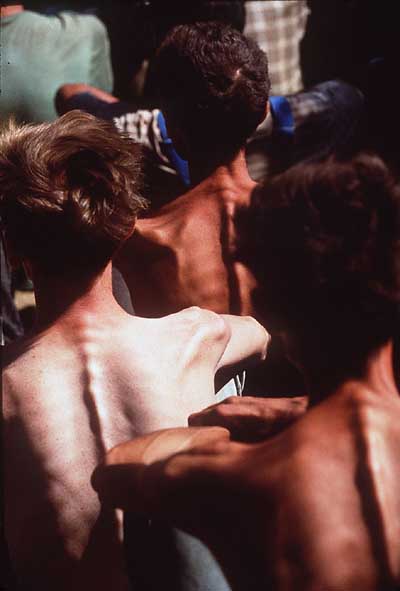 |
‘Fake’ Camp Claim Demolished
by Karen Meirik, The Hague
Prosecutors in the case against Radoslav Brđanin last week cross-examined Paul Shoup, a history professor who was called by the defence to give an assessment of the origins of the Bosnian war and the influence of both sides' propaganda. Defence lawyers were hoping that Shoup would show the court that the common perception of the Bosnian war - that Serbs were the aggressors and Muslims the victims - was not necessarily the case. But rather than prove to the court that propaganda was used equally by all sides, Shoup provided an example of just how one can be manipulated by it.
Brđanin is standing trial on genocide charges and is accused of orchestrating the ethnic cleansing of Bosanska Krajina. Since the indictment claims that the defendant ‘played a leading role in the takeover of power, in particular with respect to the propaganda campaign, which was an essential component of the plan to create a Serbian state’, the accused's responsibility for this propaganda campaign is a key issue for both prosecution and defence.
‘Demonizing the Serbs’
Claiming that Western media unfairly demonized the Bosnian Serbs, Shoup reawakened an old debate about video footage taken by the British television network ITN at the Bosnian Serb-run Trnopolje concentration camp in 1992. The footage included images of an emaciated Bosnian Muslim named Fikret Alić, who was filmed standing behind a barbed wire fence. These images - the first showing the Serb-run camps in Bosnia - shocked the world and earned the Bosnian Serb leadership condemnation around the globe.
However, five years after the footage was aired, a German reporter from the monthly Living Marxism magazine claimed that the film was staged. Calling the image ‘the picture that fooled the world’, Thomas Deichmann alleged that ITN reporter Penny Marshall had stood inside the camp, and that Alić was in fact outside. This allegation by Deichmann, who did not visit the camp during the Bosnian war, was refuted by the scores of journalists who did; but his story was seized upon by Serb nationalists and others who refused to accept that such camps ever existed.
Echoing Deichmann's claim, Shoup told the court, ‘The individual in question was in fact outside the barbed wire and the location was not a concentration camp, but a relocation centre,’ he said. Prosecutor Joanna Korner didn't mince words when she cross-examined Shoup. She asked him if he was aware that ITN had sued Living Marxism for libel following Deichmann's assertion that the network had faked the images, and that the London High Court had ruled in its favour, forcing the magazine to pay 600,000 US dollars in damages. Shoup said that he had heard about the suit, but that he had thought it only addressed the issue of whether Trnopolje was a concentration camp or a relocation centre. He said he didn't realize that the court had determined that ITN did not fake the images. ‘I have been misled,’ Shoup told the court. ‘I was fooled if that was the actual case.’
The professor’s sources
Under subsequent questioning from Korner, Shoup admitted that he had never seen the ITN footage, and that he had drawn his conclusions that the image had been faked both from the Dutch NIOD report on Srebrenica, and from a documentary by ‘The Emperor's Clothes’, an alternative news website that openly professes its admiration for former Yugoslav president Slobodan Milošević.
Although she undermined Shoup's account of how the Western media demonized the Serbs, Korner appeared to agree with much of his other testimony. ‘They [the Serbs] were pretty hopeless and ineffective in the way they waged their propaganda battle,’ Korner said. ‘In the international community, yes, I agree with you,’ Shoup said, before pointing out that within Republika Srpska (RS) the propaganda was very effective. Korner showed Shoup a Serb propaganda video that the prosecution had only just entered into evidence - an unusual move given that it has already rested its case, and the defence is in its twelfth week. The video, which appeared to be a Serb-made documentary, showed Bosnian prisoners in the  Manjača camp wearing caps of a type associated with the Serb ‘chetnik’ forces. The prisoners were shown telling reporters that they were being well treated. Shoup said that the video was propaganda material, and that the prisoners' accounts were not sincere. ‘The minute I saw the chetnik caps, I did not believe a word of what they were saying,’ Shoup said. Manjača camp wearing caps of a type associated with the Serb ‘chetnik’ forces. The prisoners were shown telling reporters that they were being well treated. Shoup said that the video was propaganda material, and that the prisoners' accounts were not sincere. ‘The minute I saw the chetnik caps, I did not believe a word of what they were saying,’ Shoup said.
Karen Meirik is an IWPR reporter in The Hague. This extract from a longer report was published in IWPR'S Tribunal Update No. 343, 16 February 2004, see www.iwpr.net
|